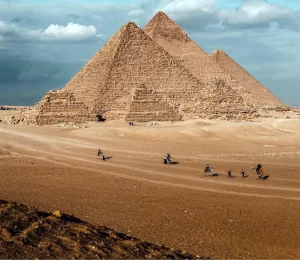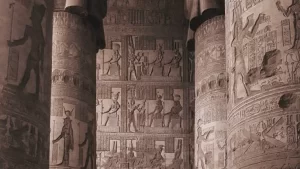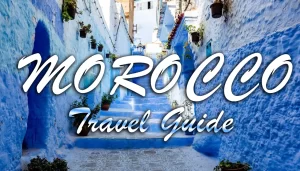Egypt: The Heart of Civilization and a Timeless Legacy

Egypt: The Heart of Civilization and a Timeless Legacy
Shaped by the blessings of the Nile and molded by the silence of the desert, Egypt has left an indelible mark on the memory of humankind for thousands of years. As Herodotus described, it is one of the world’s oldest civilizations — a bridge between the past and the future. Beneath the shadow of the pyramids lie ancient secrets; the stillness of the sphinxes, the myths of the gods, and the eternal flow of the Nile transform Egypt into not just a country, but the living memory of humanity itself.
- Egypt: The Heart of Civilization and a Timeless Legacy
- The Miracle of Geography and the Nile
- The Beginning of History
- The Social Structure of Ancient Egypt
- Egypt Through the Eyes of Herodotus
- A Legacy Beyond Time
- Kingdoms, Wars, and Beliefs – Power and Eternity in the Shadow of the Gods
- What Is a Mummy?
- Daily Life and Culinary Culture – Flavors Shaped by the Blessings of the Nile
The Miracle of Geography and the Nile
Located in northeastern Africa between the Mediterranean and the Red Sea, Egypt owes its life to the Nile River — the lifeblood of its civilization. For millennia, the Nile’s annual floods deposited fertile silt along its banks, allowing life to bloom amid the desert sands. Ancient Egyptians lived by the rhythm of the river, aligning their agricultural calendar with its floods. To them, the Nile was not merely a river but a divine being — worshipped, revered, and cherished as a spiritual connection to the gods.
The Beginning of History
Egyptian history began around 3100 BCE when King Narmer (also known as Menes) unified Upper and Lower Egypt. This event marked the rise of one of the world’s first centralized states. The Egyptians recorded their governance, trade, and religious beliefs through hieroglyphic writing. As noted by Herodotus, Egyptians valued knowledge, observation, and the laws of nature above all. Their advancements in astronomy, architecture, and mathematics became the foundation upon which future civilizations were built.
The Social Structure of Ancient Egypt
Ancient Egyptian society was strictly hierarchical. At the top stood the pharaoh — the “living god.” Below him were nobles, priests, soldiers, artisans, and farmers. Every social class depended on the Nile’s bounty, yet the will of the pharaoh reigned supreme. He embodied both earthly and divine authority, ensuring that his rule maintained cosmic order and harmony.
Egypt Through the Eyes of Herodotus
The Greek historian Herodotus described Egypt as “the oldest and wisest nation on Earth.” His accounts reveal a people deeply devoted to understanding nature and the cosmos, performing complex astronomical calculations, and nurturing a profound belief in life after death. To Herodotus, Egypt was not just a land but the birthplace of human curiosity — a living laboratory of knowledge and faith.
A Legacy Beyond Time
Today, the Great Pyramids of Giza, the Luxor Temple, Abu Simbel, and the Valley of the Kings stand as silent witnesses to Egypt’s grandeur. Each stone reflects the brilliance, devotion, and determination of human hands and minds. Egypt is not merely a relic of the past but a living stage of history, drawing millions of visitors each year to experience its enduring magic.
Egypt’s story is the story of humanity’s quest for meaning — a civilization flowing through time like the eternal Nile. To look upon Egypt is to gaze into the soul of humankind: its memory, wisdom, and belief in eternity. For this reason, Egypt is not only where history began — it is the beating heart of humanity’s endless story.
Kingdoms, Wars, and Beliefs – Power and Eternity in the Shadow of the Gods
Ancient Egypt was more than just a civilization; it was a timeless epic where faith, power, and humanity’s quest for eternity intertwined. Every stone and every hieroglyph tells a story of divine kings, great battles, and an undying spirit that defied the passage of time. This chapter unveils Egypt’s millennia-old history — its kingdoms, its gods, and its mysterious relationship with death and the afterlife.
The Old Kingdom: The Age of the Pyramids (2686–2181 BCE)
The Old Kingdom marks Egypt’s first great era, often called the Age of the Pyramids. During this time, the central government was strong, and pharaohs were revered as living embodiments of the gods. The Great Pyramids of Giza — built for Khufu (Cheops), Khafre, and Menkaure — were not mere tombs but eternal monuments of divine kingship and immortality.
Their construction was a colossal state project involving tens of thousands of workers, mathematicians, engineers, and priests. The pyramids were precisely aligned with the flow of the Nile and the positions of the stars, symbolizing the cosmic harmony between heaven and earth.

The Middle Kingdom: Rebirth and Unity (2055–1650 BCE)
After the fall of the Old Kingdom, Egypt entered a turbulent period known as the First Intermediate Period. Order was restored under King Mentuhotep II, who reunified the land from Thebes and founded the Middle Kingdom. This era was marked by administrative reforms, agricultural prosperity, and a cultural renaissance.
Pharaohs were no longer viewed solely as divine beings but also as guardians and rulers of their people. Art and literature flourished, with masterpieces like The Tale of Sinuhe exploring the relationship between destiny and divine will.
The New Kingdom: The Peak of Power and the Reign of the Gods (1550–1070 BCE)
The New Kingdom represented the height of Egypt’s imperial glory. The pharaohs extended their influence from Nubia to Mesopotamia. Among the most famous rulers were Thutmose III, Ramses II (Ramses the Great), and the remarkable female pharaoh Hatshepsut — one of the few women to ascend Egypt’s throne. Her magnificent temple at Deir el-Bahari remains one of the finest architectural achievements of the ancient world.
During this era, religion and divine kingship grew even stronger. The city of Thebes became the center of the Amun-Ra cult, and colossal temples and statues were erected as symbols of both faith and political power. The Abu Simbel temples, commissioned by Ramses II, stand as a testament to his divine authority, perfectly aligned with the rising sun to illuminate the pharaoh’s image.
The Battle of Kadesh and the World’s First Peace Treaty
In 1274 BCE, Pharaoh Ramses II led the Egyptian army against the Hittite King Muwatalli near Kadesh, in present-day Syria. The battle became one of the most well-documented military engagements of the ancient world. Although both sides claimed victory, neither achieved a decisive triumph.
Following the conflict, the two powers signed the Treaty of Kadesh — the world’s first known written peace treaty. Inscribed in both Egyptian hieroglyphs and Hittite cuneiform, it pledged mutual friendship, trade, and military alliance. This monumental event established Egypt not only as a military power but also as a pioneer in diplomacy.
Faith and the Pantheon of Gods
Ancient Egyptian religion revolved around a vast pantheon of deities. The supreme god was usually Ra, symbolizing the sun. Osiris represented death and resurrection; Isis embodied motherhood and magic; Anubis guided the dead through the afterlife; and Horus protected the sky and the throne. Egyptians believed that divine forces existed in every stone, wind, and natural phenomenon.
This worldview centered on the principle of Ma’at — the cosmic balance of justice, harmony, and universal order. The pharaoh’s duty was to preserve Ma’at and maintain the divine equilibrium of the world.
Death, for Egyptians, was not an end but a transition. Mummification ensured that the soul (ka) could recognize its body in the afterlife. In the Book of the Dead, scenes depict the heart of the deceased being weighed against the feather of Ma’at. If found pure and light, the soul was granted eternal life — a reflection of Egypt’s profound spiritual philosophy.

Archaeological Discoveries and the Mysteries of Egypt
Egyptian archaeology reveals some of humanity’s most fascinating chapters. In 1922, Howard Carter’s discovery of Tutankhamun’s tomb became one of the most significant archaeological findings of the 20th century. The golden mask, jewelry, and treasures within his burial chamber embodied Egypt’s wealth and its unshakable belief in life after death.
The discovery of the Rosetta Stone in 1799 was another milestone — it unlocked the mystery of Egyptian hieroglyphs. The trilingual decree inscribed on the stone was deciphered by Jean-François Champollion in 1822, opening the door to understanding the ancient Egyptian language and its civilization.
Transformation and an Eternal Legacy
Throughout history, Egypt was ruled successively by the Persians, Greeks, Romans, and Arabs. Yet no conqueror could erase the magic at the heart of Egypt. Each era layered new traditions upon ancient beliefs, creating a rich cultural mosaic.
Today, Egypt’s mosques, temples, and museums stand as guardians of this intertwined heritage — a living testimony to a civilization that transcends time. The true power of Egypt lies in its eternal memory, echoing through every age as a symbol of wisdom, resilience, and immortality.
The Anatomy of Death in Egypt: Mummification and the Belief in Immortality
In Ancient Egypt, death was not an end but a transformation — another form of life. Egyptians believed that a person was not merely flesh and bone, but a union of body, soul, and divine essence. Death represented a transition of this unity into another dimension. Therefore, preserving the body was considered a sacred duty, guiding the soul on its eternal journey. This belief gave rise to one of humanity’s most fascinating traditions: mummification.
What Is a Mummy?
The word mummy comes from the Arabic mūmiyā, meaning “a body preserved with bitumen or resin.” In Ancient Egypt, the term sah described a body protected after death. To Egyptians, a mummy was not a mere corpse but a vessel through which the soul could revisit the physical world.
They believed that the ka — the life force — occasionally returned to the body after death; hence, preserving the corpse was essential to ensure the soul’s safe passage to the gods.
The Purpose of Mummification
The primary goal of mummification was to allow the soul to recognize and reunite with its body. Egyptians believed every human possessed three spiritual elements: Ka (life energy), Ba (personal soul), and Akh (immortal essence). For the Ka to return, the physical body needed to remain intact. If the body decayed, the soul would be lost and could never reach eternal life.
Thus, mummification was not merely a religious act but also a cosmic duty — a sacred art combining science, ritual, and faith.
How Was Mummification Performed?
The process began immediately after death and lasted around 70 days. Priests and trained embalmers conducted the ritual in workshops near temples.
First, the body was cleansed and covered in salt. Then, the abdomen and chest cavity were carefully opened to remove internal organs — the liver, lungs, stomach, and intestines — which were preserved separately in canopic jars. These organs were believed to serve the deceased in the afterlife and were entrusted to the protection of the gods.
The most delicate step was removing the brain. Using thin metal hooks, embalmers extracted it through the nostrils, then filled the skull with oils and resins. This method represents one of the earliest known examples of cranial surgery — modern analyses show that the ancient Egyptians had surprising anatomical knowledge and surgical precision.
After organ removal, the body was dried using natron, a natural salt mixture, for about 40 days. The cavities were then filled with linen, resin, and aromatic herbs before being wrapped in linen bandages. During the wrapping, priests recited sacred prayers and placed protective amulets such as the Eye of Horus, the Ankh, and the Scarab to safeguard the soul’s journey.
Who Performed Mummification?
The embalmers were usually “Wab” priests, known for their spiritual purity. These holy men followed strict purification rituals before touching the deceased. They were regarded as early physicians, possessing detailed knowledge of anatomy and the functions of each organ.
In Egyptian belief, medicine and religion were inseparable — and these priests were considered earthly representatives of Anubis, the jackal-headed god of the dead, responsible for guiding and protecting souls on their path to eternity.
Who Performed Mummification?
The embalmers were usually “Wab” priests, known for their spiritual purity. These holy men followed strict purification rituals before touching the deceased. They were regarded as early physicians, possessing detailed knowledge of anatomy and the functions of each organ.
In Egyptian belief, medicine and religion were inseparable — and these priests were considered earthly representatives of Anubis, the jackal-headed god of the dead, responsible for guiding and protecting souls on their path to eternity.
The Birth of Medicine: Egypt and the First Brain Surgery
Egypt was not only the land of faith but also the cradle of science. Knowledge gained from mummification laid the foundation for early medical practice. Archaeological findings reveal skulls with evidence of trepanation — the world’s earliest form of brain surgery.
These procedures may have been performed to treat head injuries or neurological conditions like migraines.
Ancient medical texts such as the Ebers Papyrus and the Edwin Smith Papyrus describe treatments for wounds, bone fractures, brain disorders, and heart diseases. They demonstrate that Egyptian physicians possessed systematic understanding of surgery, anatomy, and pharmacology. Thus, mummification became a bridge between religious ritual and scientific discovery.
Modern Science and Mummy Research
Today, mummies serve as invaluable witnesses to history. Through CT scans, DNA sequencing, and isotope analysis, scientists have uncovered details about Egypt’s genetic origins, diet, and diseases.
Studies have revealed evidence of tuberculosis, arthritis, heart disease, and dental decay — proving that ancient Egyptians faced many of the same health challenges as modern humans. These findings offer an extraordinary glimpse into the evolution of human health and civilization.
The Body of Eternity
Mummification stands as one of humanity’s oldest attempts to understand — and transcend — death. By preserving the body, the Egyptians sought to eternalize the soul’s journey. Each layer of linen was a prayer; each drop of resin, a symbol of hope.
Through this sacred art, they transformed fear of death into faith in eternity. The mummies resting silently within the pyramids are not relics of the past — they are living testaments to humanity’s enduring belief in the power of immortality.
Daily Life and Culinary Culture – Flavors Shaped by the Blessings of the Nile
Life in Ancient Egypt flowed to the rhythm of the Nile — a heartbeat in sync with the river’s rise and fall, the sun’s cycle, and the turning of the seasons. The Nile’s abundance nourished not only the fields but also the people’s faith, culture, and cuisine. Everyday life in Egypt reflected a philosophy deeply connected with the divine, a social structure woven with patience, and a sacred understanding of prosperity.
Daily Life and Social Order in Ancient Egypt
Ancient Egyptian society was built on balance, order, and devotion. Every individual had a defined role in the hierarchy, and each duty was viewed as a form of service to the gods. Farmers cultivated the land, artisans shaped stone, priests offered prayers in temples, and soldiers guarded the borders of the pharaoh’s realm.
Women held remarkable rights for the era — they could own property, engage in trade, and even hold religious positions. Family was the cornerstone of society. Marriage was sacred, and children were seen as gifts from the gods. Homes were built from mudbrick, simple yet functional, reflecting a harmony with nature. At night, gazing at the starry sky beneath the goddess Nut’s celestial veil symbolized peace and divine connection.
The Nile and the Culture of Abundance
The Nile was the heart and soul of Egypt. Its annual floods turned the desert into a fertile oasis, leaving behind nutrient-rich black soil that birthed wheat, barley, flax, and date palms. Egyptians viewed this natural cycle as a divine blessing, honoring it through festivals of gratitude and prayer.
The agricultural calendar was aligned with the Nile’s rhythm — inundation, retreat, and planting seasons defined the year. Harvest festivals along the riverbanks were celebrated with music, dance, and offerings — traditions that still echo in Egypt’s modern folk culture.
The river itself was sacred. Offerings were made to Hapi, the god of the Nile, symbol of balance and abundance. Egyptians placed flowers in the water, sang hymns, and prayed for continued prosperity. Each sunrise over the Nile was seen as a sign of rebirth — a reflection of life’s eternal renewal.
The Culinary Culture of Ancient Egypt
The cuisine of Ancient Egypt was the art of creating richness from simplicity. Bread and beer were the staples of daily life — present on every table, from the pharaoh’s palace to the farmer’s hut. Bread made from barley and wheat was baked in clay ovens, while beer was a thick, slightly sour beverage consumed by all social classes.
Egyptians also enjoyed onions, garlic, lentils, dates, honey, figs, and fish. Herbs and spices such as cumin, coriander, fennel, and mint flavored their meals. Fish from the Nile was often salted or dried for preservation, and meat — particularly goose, duck, and beef — was reserved for feasts and religious ceremonies.
Cooking was considered an act of devotion. Meals offered to the gods were prepared with utmost care, blending nourishment with spirituality — a tradition that shaped Egypt’s enduring food culture.
Modern Egyptian Cuisine: From Tradition to Today
Modern Egyptian cuisine carries the essence of its ancient roots, blending tradition with contemporary flavors. Koshari, a hearty mix of rice, pasta, lentils, and chickpeas, is now Egypt’s national dish — a symbol of creativity and communal sharing. Ful medames, made from mashed fava beans, remains a breakfast staple, seasoned with olive oil, lemon, and spices. Molokhia, a green leafy stew, has been cherished for millennia as a symbol of comfort and home.
Traditional desserts often feature dates, honey, milk, and almonds. Om Ali, a creamy pastry pudding, is a festive favorite. Egyptian coffee bears the legacy of Ottoman influence, while mint tea and karkadeh (hibiscus tea) remain beloved daily beverages that accompany conversation and hospitality.
Food, Faith, and Ritual
In Egypt, food has always been more than sustenance — it is a form of spiritual sharing. The offerings once made to the gods are echoed today in Ramadan feasts, wedding banquets, and communal meals after funerals. Sharing food strengthens social bonds and reflects the ancient Egyptian principle of Ma’at — balance, harmony, and gratitude.
Eating from a shared plate symbolizes unity and connection. Every bite is both a physical and spiritual expression of thankfulness — a link between the earthly and the divine that has endured through the ages.
Cultural Continuity in Modern Egypt
Walking through the bustling streets of Cairo, one can still sense the echoes of ancient Egypt. The scent of spices in marketplaces, the songs of vendors, and the boats gliding over the Nile are living testaments to a civilization that never truly vanished.
Artisans still craft traditional designs, musicians weave ancient melodies into modern rhythms, and families pass down recipes that preserve the flavors of the past. tourism plays a vital role in this cultural continuity — every visitor who tastes Egyptian food experiences not just its flavor, but the story of humanity’s bond with nature, faith, and endurance.
The Land of Eternal Abundance
Throughout history, Egypt has symbolized fertility, resilience, and life itself. The Nile’s floods renew the land each year, teaching the wisdom of harmony between humankind and nature. Egyptian cuisine is more than nourishment — it is a living archive of memory. Each flavor carries a prayer, each aroma tells a story, and each meal connects the present with eternity.
Egypt is not merely where history began — it is where life continues to find meaning.


